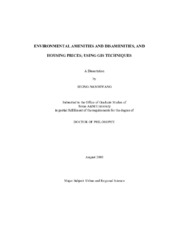| dc.description.abstract | This research investigated the effects of Scientifically Estimated Environmental Risks (SEERs) and perceived risks of floods, hurricanes, and hazardous material releases, and hazard mitigation measures with other locational and neighborhood amenities on housing prices. This study also tested the relationship between demographic characteristics and SEERs as well as demographic characteristics and environmental risk perceptions.
The relationships among these different types of variables were examined by means of statistical analyses such as correlational analyses, ANOVA, MANOVA, and hedonic price regression analyses.
Major findings of this research are as follows:
There were no statistically significant relationships between most of the demographic characteristics (age, sex, household size, marital status, tenure at the present home) and SEERs of the two natural hazards (a flood and a hurricane). By contrast, SEER of hazardous materials was correlated with all demographic characteristics.
There were little differences in risk perceptions of natural and technological hazards across demographic groups. Specifically, the respondents' risk perceptions of both natural and technological hazards did not differ by age, household size, and marital status. By contrast, educational level, gender (male = 1), and median household income were negatively related to perceived risk of the natural hazards, whereas educational attainment and gender were negatively related to perceived risk of hazardous material releases.
SEERs of floods and hurricanes were positively related to respondents' perception of property damage, but not related to injury or heath problems from those natural hazards. SEER of hazardous materials was related to all three categories of risk perception of a hazardous material release.
Neither the SEERs of natural hazards nor risk perceptions of these hazards had impacts on housing prices. However, the SEER of hazardous material releases and risk perceptions of this hazard were significant housing price determinants.
None of the variables representing household hazard mitigation measures contributed to the explanation of housing prices. | en |


